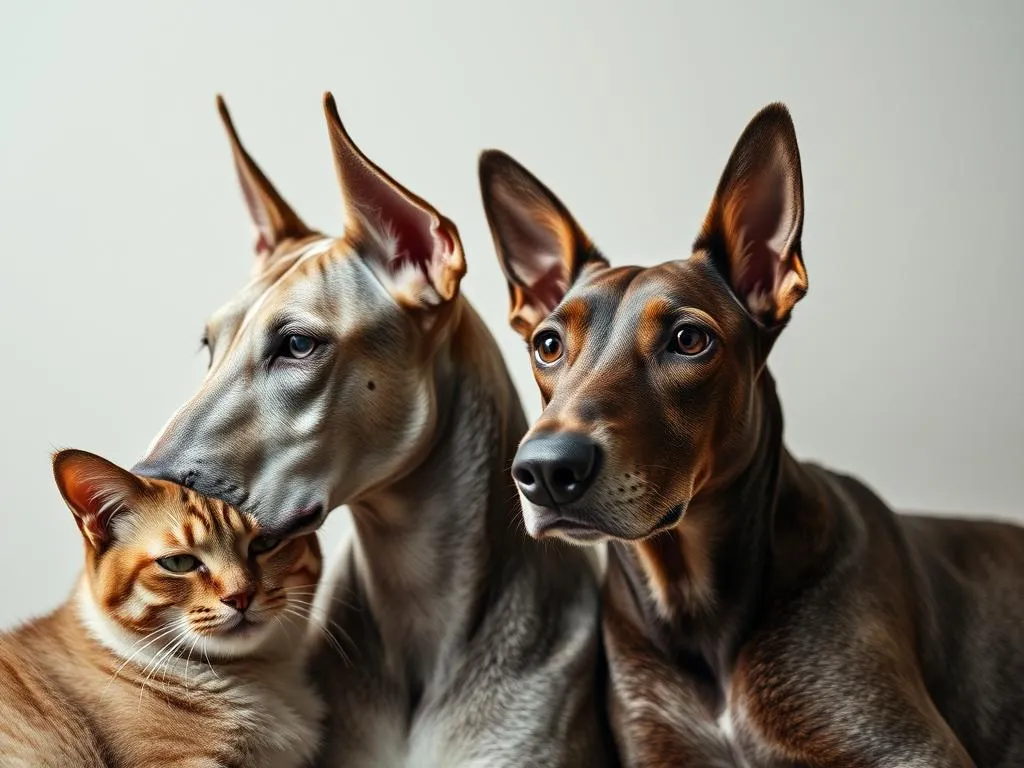
Great Danes, often referred to as “gentle giants,” are a breed known for their impressive size and friendly demeanor. These majestic dogs can weigh anywhere from 100 to 200 pounds, towering over many other pets, including cats. While their large stature might make some people question their compatibility with smaller animals, particularly cats, it is essential to delve into their temperament and behavior to understand whether do Great Danes get along with cats.
Understanding the dynamics between Great Danes and cats is crucial for pet owners contemplating this unique combination. It is not uncommon for dog owners to wonder if their Great Dane will peacefully coexist with their feline companions. This article offers insights, tips, and personal experiences from Great Dane owners, helping you navigate the often complex relationship between these two beloved pets.
Understanding Great Danes
Breed Characteristics
Great Danes are recognized for their striking appearance. With their long legs, deep chests, and commanding presence, they are hard to miss. Their short, smooth coats come in various colors, including fawn, brindle, blue, and black. Despite their imposing size, Great Danes are known for their gentle and friendly nature. They typically have a calm demeanor, often described as affectionate and loyal to their families.
Historically, Great Danes were bred for hunting large game, including boar and deer. Their size and strength made them excellent working dogs, but over time, they have evolved into beloved family pets. This historical background contributes to their temperament; Great Danes are generally friendly and sociable, traits that can influence their interactions with cats.
Socialization and Training
Early socialization is critical for any dog breed, and Great Danes are no exception. Exposing them to various environments, people, and animals during their formative months helps shape their behavior as adults. A well-socialized Great Dane is more likely to be comfortable around cats, which can significantly influence whether do Great Danes get along with cats.
Effective training techniques are also vital. Positive reinforcement methods work best for Great Danes, as they respond well to praise and rewards. Basic obedience training should be emphasized, ensuring that your Great Dane understands commands and boundaries. When introducing a Great Dane to a cat, it’s important to approach the situation calmly and with patience.
The Nature of Cat Behavior
Understanding Cat Personalities
Cats are known for their independence and unique personalities. While some cats are sociable and friendly, others can be more territorial and cautious around new animals. Understanding your cat’s temperament is crucial when considering the introduction of a Great Dane into your home.
Cats often exhibit behaviors such as climbing, hiding, or swatting to communicate their feelings. A confident cat may be more inclined to interact with a dog, while a timid or nervous cat may view a Great Dane as a threat. Recognizing these personality traits will help you anticipate how your cat might react during their first meeting.
Signs of Stress in Cats
Cats can be quite subtle in showing signs of stress. If a cat feels threatened, it may exhibit behaviors such as:
- Hiding or withdrawing
- Excessive grooming or scratching
- Aggression or hissing
- Loss of appetite
It is essential for cat owners to recognize these signs of discomfort. Creating a safe and calm environment for both pets will help facilitate a smoother introduction and promote coexistence.
Do Great Danes Get Along with Cats?
General Compatibility
When it comes to do Great Danes get along with cats, general compatibility varies. Great Danes are typically friendly and can be gentle with smaller animals, including cats. However, individual dogs may have different tendencies. Factors such as the dog’s temperament, early socialization experiences, and the cat’s personality play significant roles in determining compatibility.
Some Great Danes may exhibit a strong prey drive, especially if they have not been properly socialized or trained. This instinct can make them more inclined to chase or play rough with smaller pets, which could be harmful to a cat. Therefore, it’s crucial to consider not just the breed but also the individual behaviors of both the Great Dane and the cat.
Case Studies and Personal Experiences
Many Great Dane owners have shared their experiences regarding the compatibility of their dogs with cats. One owner recounted how their Great Dane, raised alongside a cat, became the feline’s protector. The dog would lay down next to the cat, and they quickly formed a close bond, demonstrating that positive introductions lead to successful relationships.
Conversely, another owner had a Great Dane with a high prey drive who struggled to coexist with their cat. Despite attempts at socialization, the Great Dane’s instincts made it challenging for the cat to feel safe, leading to a separation between the two animals. These stories illustrate that experiences can vary widely based on individual pet personalities and backgrounds.
Tips for Successful Coexistence
To help ensure a harmonious relationship between your Great Dane and cat, consider the following tips:
-
Gradual Introduction: When introducing a Great Dane to a cat, do so gradually. Begin by allowing them to sniff each other under a closed door before meeting face-to-face.
-
Controlled Environment: Keep both pets in a controlled environment during their initial introductions. Use a leash for the Great Dane to prevent any sudden movements that might scare the cat.
-
Safe Spaces: Create safe spaces for both pets. Cats should have access to high perches or hiding spots where they can retreat if they feel overwhelmed.
-
Monitor Interactions: Always supervise interactions, especially in the early stages. Pay attention to body language and be ready to intervene if necessary.
-
Positive Reinforcement: Reward both pets for calm behavior when they are around each other. This will help them associate each other with positive experiences.
Potential Challenges
Size and Playfulness
The significant size difference between Great Danes and cats can pose challenges. A playful Great Dane may unintentionally harm a cat simply by being too enthusiastic. Their play behavior can be quite exuberant, and what might seem like harmless fun to a Great Dane can be terrifying for a smaller animal.
It is essential to teach your Great Dane appropriate play behaviors and to monitor their interactions closely. Encourage gentle play and discourage any roughhousing that could lead to injury.
Territorial Behavior
Both Great Danes and cats can display territorial behavior, which may lead to conflicts. Cats are known for being protective of their spaces, and a Great Dane may assert dominance over certain areas in the home.
To manage territorial disputes, ensure that each pet has its own designated space. Providing separate feeding areas, sleeping spots, and toys can help minimize competition and reduce the likelihood of territorial aggression.
Expert Insights
Veterinarian and Trainer Recommendations
Veterinarians and pet trainers often emphasize the importance of socialization and training when it comes to introducing a Great Dane to a cat. They recommend that owners observe body language and be patient throughout the process. If a Great Dane shows signs of aggression or intense curiosity towards a cat, it may be best to seek professional guidance.
Many professionals suggest that the best time to introduce a Great Dane to a cat is when the dog is still a puppy. Young dogs are more adaptable and can learn to coexist with other animals more easily than older dogs. Early introductions can foster positive relationships and reduce the likelihood of issues arising later.
Resources for Further Learning
For those interested in diving deeper into the dynamics between Great Danes and cats, various resources can provide further insights. Books on dog training, feline behavior, and pet introductions can be invaluable. Online forums and communities can also offer support and shared experiences from other pet owners.
Conclusion
In summary, whether do Great Danes get along with cats depends on several factors, including individual personalities, socialization, and training. While many Great Danes can peacefully coexist with cats, it’s essential to recognize that each pet is unique. Understanding both breeds’ characteristics and behaviors can help ensure a harmonious household.
By taking the right steps during introductions and being mindful of each pet’s needs, owners can foster a loving environment for both Great Danes and cats. Ultimately, prioritizing individual personalities over breed stereotypes will lead to the best outcomes for all pets involved.









